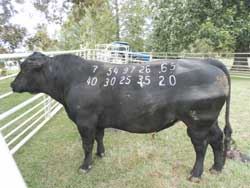|
EPDs Should Guide Purchase Of Bulls Even If They Are Not Painted On The Side Of Your Bull
MT. VERNON, MO.
“The ABC’s of EPD’s” was the title of a presentation given by Eldon Cole, a livestock specialist with University of Missouri Extension, at the recent “Field Day” held at the University of Missouri Southwest Research Center in Mt. Vernon Field Day.
“Even though we’ve been educating folks since the 1980’s about understanding and using expected progeny differences (EPDs) there are still many who are uncertain about them,” said Cole.
According to Cole, nearly anyone who has purchased a bull has heard about this wonderful selection tool that is 7 to 9 times more effective in directing change than an adjusted 365-day weight.
“I’ve never seen data indicating the effectiveness of EPDs compared to simply visually selecting a bull for growth, carcass merit, calving ease or daughter’s milking ability but it’s bound to be very high,” said Cole.
During his talk at Field Day, Cole was assisted by a cooperative, 4-year old Angus bull owned by the research center.
“I pulled off his EPDs the day before and with the help of the center staff, we paint-branded a portion of his EPDs on his side,” said Cole.
The EPDs for this young bull (shown in the accompanying photo) top row left to right are: direct calving ease (7), weaning weight (54), yearling weight (97), daughter milking ability (26) and intramuscular fat/marbling (.65).

A four-year old Angus bull served as an EPD
billboard for a presentation at the Southwest
Center, Mt. Vernon on September 11 and 12.
Photo credit: MU Extension
“These are the Angus EPDs that attract the most attention but those five traits represent only about one-third of the EPD traits used by the breed,” said Cole.
According to Cole, the 54 lb. weaning weight he compared to a bull with a 40 lb. weaning weight EPD indicates the progeny of the Center’s bull should average 14 lbs. (54-40 = 14 lbs) heavier when bred to similar females that are managed alike.
Below each EPD is the percentile rank of the bull. This often is easier for cattlemen to understand then doing the math of the EPDs.
“The percentile rank indicates the bull’s rank within the breed for an EPD. In this case, the 54 pound weaning weight EPD places him in the 30th percentile of Angus for that trait. Thus, he’s in the top 30 percent of the Angus bulls for growth to weaning,” said Cole.
Each EPD has an accuracy value from .05 to .09 based on the amount of data from his ancestors, his own progeny and even DNA data. The latter results in a genomically-enhanced EPD. It represents the equivalent of anywhere from 5 to 23 progeny results from a DNA evaluation.
“I did not show the pictured bull’s accuracy values as they are fairly low (.3±) as he’s only been used naturally in their commercial herd with no data submitted to the Angus Association,” said Cole.
Cole’s concluding message to the Field Day attendees was to never buy a bull without numbers on him.
“Granted, the bulls you might be considering will not have their EPD’s, accuracies and percentile rank painted on their sides, but those numbers are available if you have a registration number on the animal,” said Cole. ∆
|
|